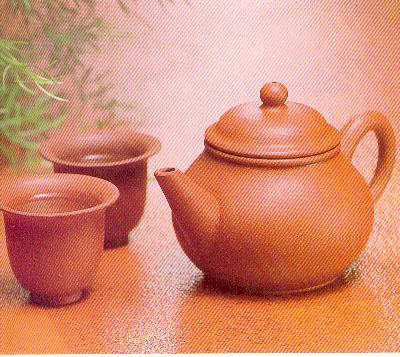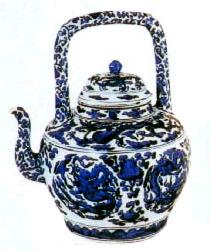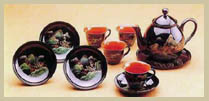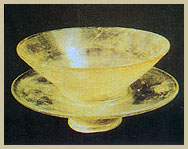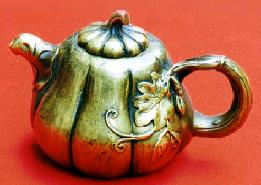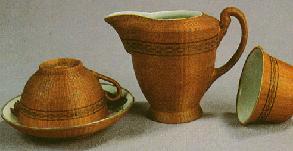In China, there are various kinds of
exquisite tea sets of both practical and artistic values. Chinese tea sets are
well known at home and abroad and favored by tea lovers through the ages. Over
the long developing history of tea drinking in China, both the customs and the
processes have gone through great changes. As for special tools for drinking
tea, tea sets have also undergone an evolution.
Major types of tea sets include:
1. Fictile Tea Sets
Among the fictile tea sets,
the purple clay tea set made in Yixing is regarded as the best one. The purple
clay teapot is made of unglazed clay, which is baked with purple and red
mud specially found in the local area. Since it is densely agglomerated and
finely molded at a high temperature, such a teapot not only can hold water
without leakage but also can absorb liquid and retain some of the flavor of the tea
due to its porous nature unperceivable by naked eye. The purple clay teapot is
slow in heat transfer, preventing one from scalding one's hand. It can also
keep tealeaves from spoiling in hot days. More over, such kind of teapot can
stand sharp changes in temperature and even be put directly on fire to stew tea
if required. The purple clay tea set also features simple design and
unsophisticated color and takes various shapes, such as bamboo knot, lotus root,
pine tree knot and bronze ware imitating that of the Shang (17th-
11th century BC) and Zhou (11th century BC - 256BC)
Dynasties.
2. Porcelain Tea Sets
1)
White-porcelain tea sets: the most
famous white-porcelain producing area is Jingdezhen, and other areas include
Liling of Hunan Province, Tangshan of Hebei Province and Qimen of Anhui
Province. In the Yuan Dynasty, Jingdezhen was well known for its celadon that
enjoyed a hot sale overseas.
2) Celadon tea
sets: celadon tea sets began to enjoy popularity from the Jin Dynasty, and
reached its height of splendor in the Song Dynasty when Longquange Kiln of
Zhejiang Province, one of the five famous kilns at the time, produced various
kinds of celadon products, including teapots, tea bowls, cups and trays,
etc.
3) Black-porcelain tea sets: In the Song Dynasty (960-1279), tea contest
was prevalent in Fujian. Contestants believed that black-porcelain tea cup made
in Jian'an was the most suitable ware to improve tea quality, thus such tea sets
gradually gained a high reputation far and near. As described in the Record
of Tea by Cai Xiang of the Song Dynasty, To make the water appear limpid,
better use black-porcelain cups. Cups made in Jian'an are dark purple in color,
with fine lines like rabbit hair. The most notable advantage of these cups is
that they are hard to cool down if heated for a long time due to their thick
base. Cups made in other places, either thin or of purple color, cannot compare
to such cups. Contestants don not use celadon cups.
3.
Lacquer Tea Sets: Lacquer tea
sets were put into use in the Qing Dynasty and mainly made in Fuzhou area of
Fujian Province. Various kinds of lacquer tea sets were produced in Fuzhou, such
as shining treasure sands, glazed spun gold, archaized porcelain, carved and
paint and silver-embedded. After the adoption of new techniques, such as red
gold dust and carved pattern of flowers, the tea sets became more colorful and
lovable.
4.
Glass Tea Sets: In modern times,
glass tea sets have gone through great development. Glass, transparent and with
dazzling luster, is a plastic material used widely. Using glass cup to make tea,
one can enjoy a good view of the bright color of the water and the tender
tealeaves that are pushed up and down when water is poured in and then slowly
stretch. Watching such a process is like appreciating a kind of dynamic art,
especially when one makes top-grade tea. Mist rises from green water in the
crystal-clear glass cup, with tender tea buds and leaves lying at the bottom.
Glass tea sets have some disadvantages, such as breakable and easier to transfer
heat than porcelain.
5.
Metal Tea Sets: Metal has great
advantage over other materials in tea storage, and tin is the best one compared
to all other metals such as gold, silver and copper. Tin pot is mostly made with
small mouth and long neck together with a tube-shaped body. Such kind of
airproof tin pot can guard tea against moisture, oxidation, light and peculiar
smell. In the Tang Dynasty, imperial family drank Guzhu tea which should be made
with water from the Jinsha Spring. The spring water was sent directly to
Chang'an in unbreakable tin pots. But ordinary people could not afford such pots
because they were too expensive.
6.
Bamboo and Wooden Tea Sets: In past
days, large rural areas, including tea-producing areas, used bamboo or wooden
tea sets to make tea because they were cheap but with good quality. But such tea
sets are seldom used nowadays, except some bamboo and wooden pots that are used
to store tea, especially teapots made of boxwood and reed-bamboo. These two
kinds of pots are artworks, both precious presents to friends and practical
articles for one's own use.
In Chinese history, there were also tea sets
made of jade, crystal and agate, but they did not play an important role in the
evolution of tea sets because they were expensive, hard to make and of little
practical value. These tea sets were mainly regarded as a luxury, boasting of
their owners' wealth.

